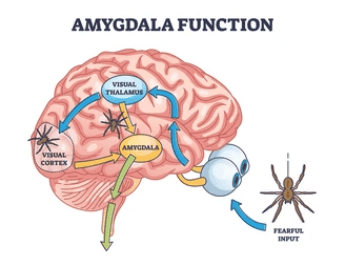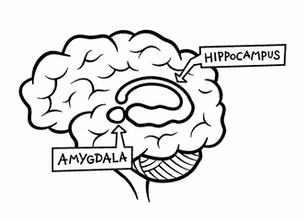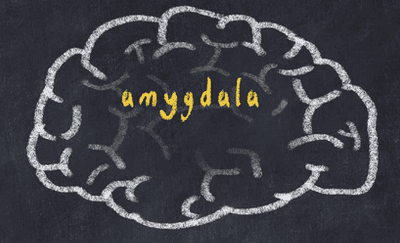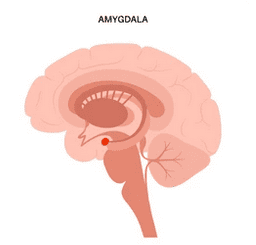The Intricacies of the Fear Center in the Brain
The Gateway to Our Anxieties: Defining the Fear Center
Imagine a secret chamber hidden deep within the labyrinthine folds of your brain, responsible for unlocking a primal emotion that has safeguarded our species throughout evolution – fear. This enigmatic region, commonly referred to as the “fear center,” is none other than the amygdala, a small yet powerful structure located within our brain’s temporal lobes.
The amygdala acts as a sentinel, perpetually vigilant in detecting potential dangers from our surroundings and triggering an innate response that prepares us to face or flee from perceived threats. The fear center, or amygdala, serves as a crucial hub for processing emotions and assigning significance to stimuli that evoke fear or anxiety.
It acts as an emotional compass, guiding our responses and helping us navigate through potentially hazardous situations. While it may seem counterintuitive to cherish and understand something associated with such discomforting feelings, delving into the intricacies of this fear center can shed light on how we perceive danger and cope with it.
Pronunciation: A-mig-dal-ah

Why Unraveling Our Fears Matters: The Importance of Understanding the Fear Center
Comprehending the inner workings of our emotions isn’t merely an academic exercise; it holds significant practical implications in various realms of human existence. From psychology to neurobiology, understanding how our brain processes fear enables us to grasp why certain individuals are more prone to anxiety disorders while others seem impervious to life’s uncertainties. By unraveling the mysteries surrounding this intricate neural network responsible for generating fear responses, scientists can develop targeted therapies and interventions for those grappling with debilitating conditions like phobias or post-traumatic stress disorder (PTSD).
Moreover, comprehending fear processing also aids in comprehending decision-making processes influenced by emotional factors. This knowledge has far-reaching consequences, extending into fields such as marketing, politics, and even the criminal justice system.
Exploring the complexities of the fear center engenders a profound appreciation for our species’ resilience and adaptability. It reminds us that fear, although often maligned, is an integral part of our human experience.
Through understanding this primal emotion and embracing its lessons, we can navigate life’s twists and turns with greater self-awareness and emotional dexterity. So let us embark on this captivating journey into the depths of our own minds to unravel the enigmatic nature of fear and its profound impact on our lives.
Overview of the Brain’s Fear Center
Fear is a fundamental human emotion that plays a crucial role in our survival. It alerts us to potential dangers, triggers the infamous fight-or-flight response, and helps us make decisions about our safety.
But have you ever wondered where this powerful emotion originates in our brains? Look no further than the amygdala, often referred to as the fear center of the brain.
Location and Structure of the Fear Center (Amygdala)
The amygdala is a small, almond-shaped structure located deep within the temporal lobes of the brain. Situated on both sides of the brain, it forms an integral part of the limbic system, which is responsible for emotions, memory formation, and behavioral responses. Within this intricate web of neural connections lies two distinct regions: the basolateral complex (BLA) and central nucleus (CeA).
The BLA receives sensory information from various sources such as visual and auditory systems. In contrast, the CeA acts as a hub for regulating emotional responses and coordinating physiological reactions associated with fear.
Role of the Amygdala in Processing Fear and Emotional Responses
The amygdala holds immense power when it comes to processing fear-related stimuli. When we encounter a potential threat or danger, sensory information from our environment is relayed to different parts of our brain for interpretation.
The amygdala swiftly assesses this information for any signs of danger by evaluating its emotional significance. Upon detecting a potential threat or fearful stimulus, such as a snake or an aggressive gesture from someone else, various pathways are activated within the amygdala.
These pathways connect with other parts of our brain responsible for decision-making and arousal regulation—such as the prefrontal cortex and hippocampus—resulting in the release of stress hormones and the initiation of appropriate behavioral responses. Not only does the amygdala contribute to fear processing, but it also plays a vital role in generating emotional responses to both positive and negative stimuli.
It helps us recognize and react to emotions like joy, sadness, anger, and pleasure. Its involvement in emotional processing goes beyond fear alone, making it an essential component for understanding our complex human experience.
Functions of the Fear Center
Detection and interpretation of potential threats
The fear center, located in a small almond-shaped structure known as the amygdala, plays a crucial role in our survival by detecting and interpreting potential threats in our environment. It acts as a vigilant sentry, constantly scanning sensory information from our surroundings for any signs of danger.
This includes visual cues such as a snarling dog or auditory clues like a sudden loud noise. Once the fear center identifies a potential threat, it swiftly initiates a series of physiological and psychological responses to ensure our safety.
Activation of fight-or-flight response
One of the key functions of the fear center is to activate the well-known fight-or-flight response when faced with imminent danger. This ancient survival mechanism prepares our bodies to either confront the threat head-on or flee from it.
When triggered, the amygdala sends signals to various parts of the body via neural pathways, which results in an increased heart rate, heightened senses, dilated pupils, and an adrenaline surge. This rapid physiological reaction enables us to either face the danger with heightened strength and focus or escape from it with increased speed.

Influence on decision-making and risk assessment
Beyond its role in immediate threat detection and response, the fear center also influences our decision-making processes and risk assessment abilities. The activation of this region can significantly impact how we evaluate potentially risky situations or make choices related to survival.
For example, if we encounter something that has previously caused us harm or generated intense fear responses stored in our memory banks, this input can bias our subsequent decision-making process towards avoiding similar situations altogether. In essence, the fear center helps us navigate through life by providing us with valuable information about potential dangers while shaping how we perceive risks and make choices accordingly.
Although its size may be small, the fear center in the brain, or the amygdala, serves vital functions in our survival and well-being. It detects and interprets potential threats, triggering the fight-or-flight response to help us cope with immediate danger.
Furthermore, it influences our decision-making processes and risk assessment abilities based on past experiences stored in our memory. Understanding the functions of the fear center can give us insight into how fear affects our behavior and ultimately allows us to develop strategies for managing fear effectively.
Neural Pathways Involved in Fear Processing
Interaction between Amygdala and Sensory Systems
When it comes to fear processing, the amygdala, located deep within the brain’s temporal lobe, plays a crucial role in integrating sensory information from various systems. Visual stimuli, such as a snake slithering across the ground or a menacing shadow lurking in the dark, are processed by the visual cortex and swiftly transmitted to the amygdala.
This rapid relay allows for immediate assessment of potential threats without conscious awareness. Similarly, auditory cues like a sudden loud noise or an eerie whisper activate the auditory cortex, which quickly sends signals to the amygdala for evaluation.
But it doesn’t stop there – other sensory systems also contribute to fear processing. The olfactory system detects odors associated with danger, like the pungent scent of smoke or the putrid smell of rotting food that may harbor harmful bacteria.
Even tactile sensations play a role. Imagine feeling something slimy and cold crawl across your skin; your somatosensory system sends this information to the amygdala for assessment.
Communication with Other Brain Regions
The amygdala doesn’t make fear-related decisions in isolation; it collaborates with other brain regions to inform our responses and behaviors. One key partner is the hippocampus, involved in memory formation and consolidation.
This connection allows emotional memories associated with fear-inducing events to be stored and retrieved later on. For example, if you were bitten by a dog as a child, your amygdala would encode that experience as frightening while your hippocampus would help cement it into long-term memory so that you can recall it years later.
Additionally, communication between the amygdala and prefrontal cortex is vital for regulating fear responses. The prefrontal cortex is responsible for executive functions such as decision-making and risk assessment.
It receives input from the amygdala, allowing it to evaluate whether a perceived threat is genuine or exaggerated. In situations where fear might hinder logical thinking, this connection helps to modulate and balance our responses.
Understanding the intricate neural pathways involved in fear processing gives us insight into how our brains react to potential threats. The interplay between the amygdala and sensory systems ensures that we can rapidly detect and assess danger from various sources.
The communication between the amygdala, hippocampus, and prefrontal cortex enables us to form emotional memories associated with fear-inducing events and regulate our fear responses in a balanced manner. Such knowledge contributes to a deeper understanding of the human brain’s remarkable ability to navigate the complex world of emotions.
Impact on Emotional Memory Formation
Role in encoding emotional memories associated with fear-inducing events
Fear is not only a powerful emotion but also plays a crucial role in the formation of our memories. When we encounter fear-inducing situations, our brain’s fear center, known as the amygdala, is activated. The amygdala acts as a gatekeeper for emotional experiences and serves as the main hub for processing and storing memories tied to fearful events.
It works in concert with other brain regions to ensure that these memories are encoded effectively. During an emotionally charged experience, such as encountering a threat or facing a phobia, the amygdala is at the forefront of processing and encoding information about what happened.
It carefully evaluates sensory inputs from various channels like sight, sound, and smell, filtering them for potential threats. Once it detects danger, it rapidly sends signals to other parts of the brain to initiate appropriate responses like fight or flight.

Enhanced memory consolidation for emotionally charged experiences
Not only does the fear center play a role in encoding fearful memories but it also contributes significantly to their consolidation. Consolidation refers to the process by which memories are strengthened and stored long-term. Emotionally charged experiences tend to leave a lasting impact on our memory due in large part to the involvement of the amygdala.
When we experience something fear-inducing or traumatic, heightened emotions activate stress hormones like cortisol that influence memory consolidation. Studies have shown that increased levels of cortisol during stressful events can enhance memory formation by facilitating communication between different brain regions involved in memory processes.
Link between fear center activation and PTSD development
Post-Traumatic Stress Disorder (PTSD) is a mental health condition that can develop following exposure to traumatic events such as accidents, violence, or war. Individuals with PTSD often experience intrusive thoughts, nightmares, and intense anxiety related to the traumatic event.
The fear center’s role becomes significant in understanding the development of this disorder. Research suggests that repeated activation of the amygdala during traumatic events can lead to an overactive fear response, impairing the extinction of fear memories.
This means that individuals with PTSD may continue to feel intense fear and re-experience traumatic events long after they have occurred. Understanding how the fear center functions in PTSD can help researchers develop targeted therapies aimed at dampening excessive fear responses and promoting recovery.
The amygdala, or fear center of the brain, plays a critical role in encoding emotional memories associated with fearful events. It ensures that these memories are consolidated effectively through complex interactions with other brain regions and stress hormones.
However, dysfunction in this system can also contribute to the development of conditions like PTSD. By delving deeper into our understanding of how the fear center operates, we open up new possibilities for therapeutic interventions that may alleviate excessive anxiety and provide relief for those who suffer from debilitating fears.
Modulation of Fear Responses by External Factors
Influence of Stress Hormones on Fear Processing
Stress hormones, such as cortisol and adrenaline, play a crucial role in the modulation of fear responses in the brain. When faced with a potentially threatening situation, the fear center (amygdala) becomes activated, triggering the release of these hormones.
Cortisol increases alertness and prepares the body for action, while adrenaline heightens arousal and enhances our ability to respond quickly. The presence of cortisol facilitates fear memory consolidation, making it easier for us to remember fearful experiences.
This can be both beneficial and detrimental – while enhanced memory can help us avoid danger in the future, it may also contribute to anxiety disorders or traumatic memories. Additionally, chronically elevated levels of stress hormones can disrupt normal fear regulation mechanisms and lead to exaggerated fear responses.
Effects of Neurotransmitters on Anxiety Regulation
Neurotransmitters such as serotonin and gamma-aminobutyric acid (GABA) also play a crucial role in regulating anxiety within the brain’s fear center. Serotonin is involved in mood modulation and has an inhibitory effect on fear responses.
Low levels of serotonin have been associated with increased anxiety and heightened vulnerability to stressors. On the other hand, GABA acts as an inhibitory neurotransmitter that reduces neuronal activity within the amygdala, thereby dampening fear responses.
GABAergic pathways help regulate anxiety by counteracting excessive excitability within the amygdala. Dysregulation of GABAergic neurotransmission may contribute to various anxiety disorders.
Disorders Associated with Dysfunctional Fear Center Activity
Anxiety Disorders: Generalized Anxiety Disorder (GAD), Panic Disorder, Specific Phobias
Anxiety disorders are characterized by excessive feelings of worry or fear that interfere with daily life. Generalized Anxiety Disorder (GAD) involves persistent and excessive worrying about various aspects of life, even when there is no apparent threat.
Panic Disorder is characterized by sudden and recurrent panic attacks, accompanied by intense physical symptoms such as rapid heartbeat, shortness of breath, and dizziness. Specific Phobias involve an intense fear or avoidance of specific objects or situations.
These anxiety disorders often arise due to dysfunction within the fear center of the brain. Hyperactivity in the amygdala, coupled with abnormal regulation of stress hormones and neurotransmitters, can contribute to exaggerated fear responses in these individuals.
Post-Traumatic Stress Disorder (PTSD)
Post-Traumatic Stress Disorder (PTSD) is a disorder that develops after experiencing or witnessing a traumatic event. In individuals with PTSD, the fear center becomes hyperactive and hypersensitive to trauma-related cues long after the event has occurred. This results in intrusive memories, flashbacks, hypervigilance, and avoidance behaviors.
Dysfunctional fear processing in PTSD involves alterations in neural circuits connecting the amygdala with other brain regions involved in memory encoding and regulation. The persistent activation of traumatic memories contributes to the distressing symptoms experienced by individuals with PTSD.

Neuroimaging Techniques to Study the Fear Center
Functional Magnetic Resonance Imaging (fMRI) Studies
Functional Magnetic Resonance Imaging (fMRI) allows researchers to visualize brain activity by measuring changes in blood flow and oxygenation levels. fMRI studies have provided valuable insights into how different regions within the fear center interact during fear processing tasks. By examining patterns of activation in response to fearful stimuli or traumatic memories, researchers can better understand how abnormalities in neural networks contribute to anxiety disorders and PTSD.
Electroencephalography (EEG) Studies
Electroencephalography (EEG) measures electrical activity in the brain through electrodes placed on the scalp. This non-invasive technique provides valuable information about the timing and synchronization of neural activity.
EEG studies have helped identify specific brainwave patterns associated with fear processing, such as increased theta and decreased alpha waves in individuals with anxiety disorders. By analyzing these patterns, researchers gain insights into the underlying mechanisms of fear regulation and potential biomarkers for diagnosing and treating fear-related disorders.
Conclusion
Understanding the intricate workings of the fear center in the brain is crucial for comprehending anxiety disorders and PTSD. The modulation of fear responses by external factors, such as stress hormones and neurotransmitters, highlights the complexity of our emotional experiences.
Neuroimaging techniques like fMRI and EEG provide invaluable tools for studying these processes. While anxiety disorders and PTSD can be debilitating conditions, ongoing research offers hope for effective treatments that target dysfunctional fear center activity directly.
By unraveling the mysteries of our brain’s fear center, we pave the way for interventions that can alleviate suffering and improve mental well-being. Let us embrace this knowledge with optimism, knowing that a deeper understanding of our fears brings us closer to a future where they no longer hold us captive.

